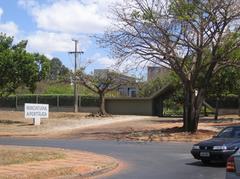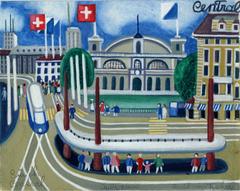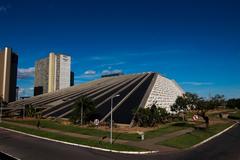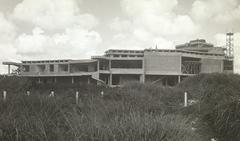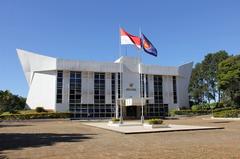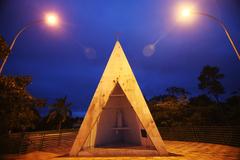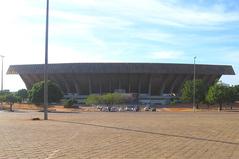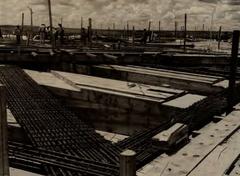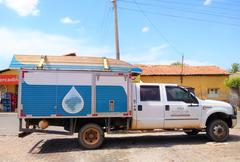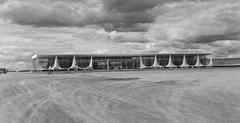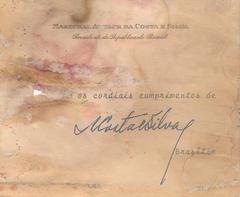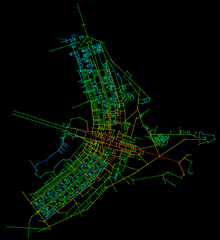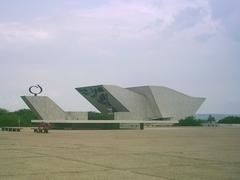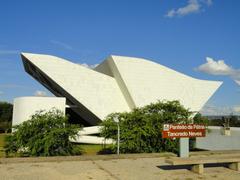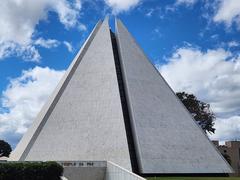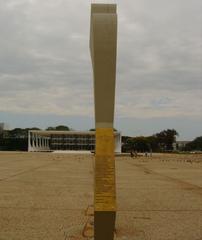Visiting the Embassy of Italy in Brasília, Brazil: Visiting Hours, Tickets, and Visitor Tips
Date: 04/07/2025
Introduction
Located in Brasília’s visionary Embassy Sector, the Embassy of Italy is both a pillar of Italy–Brazil diplomatic relations and an architectural landmark. Since its inauguration in 1960, the embassy has symbolized the strengthening of bilateral ties and the fusion of Italian modernism with Brazilian avant-garde design. Conceived by the renowned engineer Pier Luigi Nervi, the building stands as a testament to innovation and cross-cultural dialogue—a must-see for architecture enthusiasts and those interested in international relations (ArchDaily, Architectural Review).
Beyond its striking architecture, the Italian Embassy is an active center for consular services, cultural events, and community engagement. Visitors can access visa and passport services, participate in Italian cultural programs, and enjoy a prime location close to other diplomatic and cultural attractions. This detailed guide will provide historical context, visitor information, architectural highlights, and tips for a rewarding experience at the embassy and nearby landmarks such as the Palazzo Pamphilj—home of the Brazil-Italy Cultural Centre (CCBI) (123Embassy, ambbrasilia.esteri.it, CCBI).
Table of Contents
- Introduction
- Historical Context and Significance
- Architectural Highlights
- Visiting Information
- Frequently Asked Questions (FAQ)
- Palazzo Pamphilj: Italian-Brazilian Cultural Heritage
- Italian-Brazilian Relations: Cultural and Diplomatic Impact
- References and Resources
Historical Context and Significance
Italy–Brazil Diplomatic Relations and Brasília’s Embassy Sector
The Italian Embassy’s establishment coincided with Brasília’s birth in 1960, reflecting Italy’s commitment to Brazil’s modernization and the strengthening partnership between both countries. Brasília’s “Setor de Embaixadas” (Embassy Sector) was intentionally designed to house embassies representing national identities within a modernist urban plan (ArchDaily). Italy’s early and prominent presence signaled its role as a leader in diplomatic, economic, and cultural exchange in Latin America.
The Embassy’s Role in Brasília’s Urban Vision
Brasília’s Embassy Sector is a showcase of international modernist architecture, with each mission expressing its country’s identity while contributing to the city’s unique harmony. The Italian Embassy exemplifies this, harmonizing Italian design with Brazilian urban ideals (Architectural Review).
Architectural Highlights
Pier Luigi Nervi’s Modernist Masterpiece
- Innovative Concrete Structure: The embassy is a prime example of Nervi’s mastery of reinforced concrete, with ribbed surfaces and sweeping lines that balance solidity and openness.
- Landscape Integration: Set amid landscaped gardens and reflecting pools, the building’s placement creates a tranquil, inviting environment.
- Modernist Ideals: The design emphasizes clarity, functionality, and honest use of materials, embodying both Italian tradition and Brasília’s futuristic vision.
- Symbolic Details: Structural elegance, cantilevered roofs, and rhythmic facades evoke Italy’s engineering prowess and cultural identity while engaging with Niemeyer’s and Costa’s modernism.
Internally, the embassy features naturally lit halls, Italian furnishings, and artwork, further reinforcing cultural connections (ArchDaily).
Visiting Information
Location and Accessibility
- Address: SES - Avenida das Nações, Quadra 807, Lote 30, 70420-900 Brasília, DF, Brazil (Embassies.info)
- Access: Best reached by car or taxi; limited public transport options due to Brasília’s design. The embassy is accessible for visitors with disabilities.
Visiting Hours and Entry
- Regular Hours: Monday to Friday, 9:00 AM to 5:00 PM. Note that hours may vary on Italian/Brazilian public holidays—confirm on the official website.
- Appointments: Required for all consular services and most visits. Book online or contact the embassy by phone (+55 61 3442 9900) or email ([email protected]) (123Embassy).
- Entry Requirements: Bring valid identification and relevant documents. Security screening is mandatory. Photography inside is restricted except during authorized events.
Tours, Events, and Visitor Tips
- Guided Tours: Offered on special open days or during cultural events; check the embassy’s website and social media for announcements.
- Cultural Events: The embassy hosts exhibitions, lectures, and Italian national celebrations—some open to the public.
- Visitor Tips:
- Arrive at least 15 minutes before your appointment.
- Prepare all required documents in advance.
- Staff speak Italian, Portuguese, and English.
- Exterior photography is usually allowed from public spaces.
- The Embassy Sector is generally safe, but standard travel precautions apply (Caroline Rose Travel).
Consular Services
- For Italian Citizens: Passport issuance/renewal, notarial/legal services, assistance in emergencies, and support for repatriation.
- For Brazilians/Residents: Visa applications, legalizations, and information on travel to Italy.
- Cultural Promotion: The embassy supports Italian language, business, and heritage programs in collaboration with local and national partners.
Frequently Asked Questions (FAQ)
Q: What are the embassy’s visiting hours?
A: Monday to Friday, 9:00 AM to 5:00 PM. Confirm hours online.
Q: Can I visit without an appointment?
A: Appointments are required for most services and visits.
Q: Is photography allowed?
A: Exterior only, unless authorized during special events.
Q: Are there entrance fees?
A: No, entry is free for visitors.
Q: How do I book an appointment?
A: Use the official website or contact the embassy directly.
Palazzo Pamphilj: Italian-Brazilian Cultural Heritage
About the Palazzo Pamphilj and CCBI
The Palazzo Pamphilj, home to the Brazil-Italy Cultural Centre (CCBI), is a monument to the enduring ties between Italy and Brazil. This landmark in Brasília’s diplomatic quarter hosts exhibitions, concerts, and educational programs celebrating Italian heritage (CCBI).
Visiting and Access
- Address: Praça dos Três Poderes, Brasília, Federal District, Brazil
- Hours: Tuesday to Saturday, 10:00 AM to 6:00 PM
- Admission: Free; booking guided tours in advance is recommended.
Accessibility
- Ramps and elevators make the site accessible to all visitors.
Tours and Events
- Guided Tours: Available in Portuguese, Italian, and English; last about 60 minutes.
- Events: Art exhibitions, concerts, lectures, and workshops. Some events require prior registration—check the CCBI website for details.
Visitor Tips
- Book tours online to secure your spot.
- Photography is allowed, but flash and tripods are prohibited.
- Family-friendly environment.
Getting There
- By Metro: Central station, then taxi.
- By Car: Limited parking; taxis or public transport recommended.
Nearby Attractions
Explore other nearby sites, such as:
- Itamaraty Palace
- National Museum of the Republic
- Cathedral of Brasília
Italian-Brazilian Relations: Cultural and Diplomatic Impact
The Embassy of Italy and the Palazzo Pamphilj together reflect the depth of Italian-Brazilian relations, established in 1859 and strengthened through migration, trade, and cultural initiatives. Events like the 2024 visit of Italian President Sergio Mattarella highlight ongoing cooperation and celebrate shared heritage. The embassy and cultural center continue to foster dialogue, community engagement, and appreciation of Italian culture in Brazil.
Final Tips and Summary
The Embassy of Italy in Brasília is not only an architectural masterpiece but also a vibrant center for diplomatic and cultural exchange. Plan your visit in advance—book appointments, check for special events, and explore the wider Embassy Sector for a comprehensive experience. Don’t miss the opportunity to visit the Palazzo Pamphilj for in-depth exposure to Italian-Brazilian heritage and cultural programming.
Stay informed via the official embassy website and the CCBI website, and consider using the Audiala app for guidance, schedules, and event alerts.
References
- This guide is informed by official and authoritative sources, including:
For further details and the latest updates, visit the websites above or contact the embassy directly.
